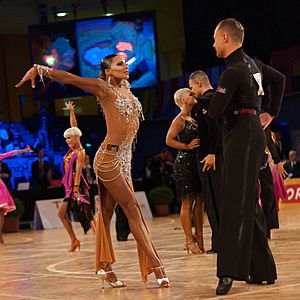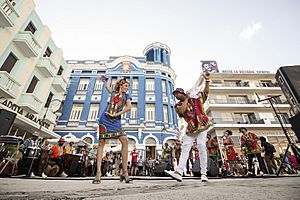Rumba facts for kids
The word rumba can mean many different types of music and dance. In Cuba, where it started, "rumba" first meant "party." By the late 1800s, it described a group of lively Cuban music styles called Cuban rumba. Over time, the word spread around the world. In different countries, "rumba" began to mean new music and dance styles. Many of these new styles are only a little bit like the original Cuban rumba, or not at all!
Why so many meanings? The word "rumba" has a confusing history. Also, it was often used like the word guaracha in Cuban shows. For a long time, "rumba" was also the main way to sell Cuban music in North America, West Africa, and Central Africa. This was before other styles like mambo and salsa became popular.
The word "rumba" came into English around 1919. By 1932, people even used it as a verb, like "to rumba," meaning to do the ballroom dance.
To help tell the difference, the English spelling "rhumba" is now used for the ballroom dance. In the early 1900s, "rumba" also became a fast-paced style in Spanish flamenco music, inspired by Cuban guaracha. Across Latin America, "rumba" often referred to local dance styles that had Cuban influences, like Colombian rumba criolla. In Africa, "rumba" became a general term for Afro-Cuban music. Later, this led to new African styles based on Cuban music, such as Congolese rumba.
Contents
What is Cuban Rumba?
In the late 1800s, Afro-Cuban workers in poor areas of Havana and Matanzas (cities in Cuba) created several new dance music styles. These mixed styles later became known as "rumba." The word "rumba" itself also meant "party."
Traditionally, there are three main types of Cuban rumba:
- yambú
- columbia
- guaguancó
Each of these styles has its own special dance, rhythm, and way of singing. Even though Cuban rumba is a traditional folk music, new ideas have been added since the mid-1900s. This includes new styles like batá-rumba and guarapachangueo.
Rumba in North America
In the United States, the word "rhumba" (the English spelling of rumba) started to be used in the 1920s. It described ballroom music with Afro-Cuban sounds, especially in big band music. This music was mostly inspired by son cubano, a different Cuban style, and was not related to traditional Cuban rumba.
By the 1930s, this rhumba music became very popular. Songs like "The Peanut Vendor" by Don Azpiazú and artists like Xavier Cugat helped it grow. The rhumba dance that developed in the eastern U.S. was based on the bolero and son dances. The first rhumba dance competition happened in 1930 at the Savoy Ballroom. Today, there are two main styles of ballroom rhumba: American style and International style.
In the 1940s and 1950s, Mexican and American movies helped spread the word "rumba." Films called rumbera films became popular. In these movies, rumberas were famous Cuban and Mexican singers and actresses. They often sang boleros and canciones, but rarely actual rumbas. Famous rumberas included Rita Montaner and Ninón Sevilla.
In the 1970s, salsa became a popular music and dance style in the U.S. Elements of Cuban rumba, especially guaguancó, became common in salsa music, along with son. Like salsa, rhumba was then danced to salsa bands instead of big bands. By the end of the 1900s, rhumba was also danced to pop music and jazz bands, as seen on TV shows like Dancing with the Stars.
Rumba in Spain
In Spain, the word "rumba" arrived in the early 1900s as rumba flamenca. This is one of the styles of flamenco music. Some people think flamenco might have influenced Cuban rumba's singing style. However, music experts agree that rumba flamenca does not come from Cuban rumba. Instead, it comes from guaracha, a fast music style from Havana. Besides rumba flamenca, other mixed styles with Afro-Cuban roots have been called "rumba" in Spain, like the Galician rumba.
In the late 1950s, popular artists like Peret (known as El Rey de la Rumba or "The King of Rumba") and El Pescaílla created a fast-paced style. It mixed parts of rumba flamenca, Spanish gypsy music, and pop. This new style became known as Catalan rumba (rumba catalana). In the 1980s, the French group Gipsy Kings made this style famous around the world.
In the 1990s, the term "tecno-rumba" was used for the music of groups like Camela and Azúcar Moreno. Since the early 2000s, "rumba" in Spain has also referred to newer styles that mix Catalan rumba with hip hop and rock. Artists like Estopa and Melendi play this kind of music.
Rumba in Colombia
In the late 1930s and early 1940s, a new music style called rumba criolla (creole rumba) was created in Colombia. It was a mix of bambuco and Afro-Cuban music. Artists like Emilio Sierra helped develop it. Rumba criolla has different regional styles, such as rumba antioqueña and rumba tolimense.
Rumba in Africa
In the 1930s and 1940s, Afro-Cuban son groups like Septeto Habanero were played on the radio in Léopoldville (now Kinshasa, Congo). Their music became very popular. Their songs were also sold on records across Africa. Local bands tried to sound like Cuban son, but they incorrectly called it "rumba." This music became known as Congolese rumba or rumba Lingala.
By the late 1960s, Congolese rumba was a well-known music style in most of Central Africa. It also influenced music in West and East Africa. Franco's OK Jazz and Le Grand Kallé's African Jazz were some of the most successful Congolese rumba bands. A faster style called soukous (from the French word for "to shake") was developed in the late 1960s by bands like African Fiesta. Sometimes, "soukous" is used to mean the same thing as Congolese rumba.
See also
 In Spanish: Rumba criolla para niños
In Spanish: Rumba criolla para niños



